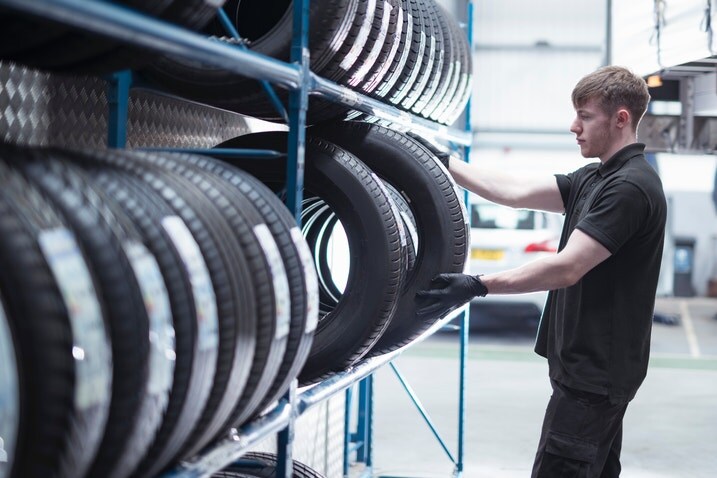Photo: Monty Rakusen | DigitalVision via Getty Images
Tires are the most important part of your car. They're the only part of your vehicle that touches the road, and so all of your other inputs — acceleration, braking, and steering — are filtered through your tires. Tires come in all different specifications, tread patterns, rubber compounds and, of course, sizes. Tire size is important because it affects your car's ground clearance, gear ratio and more. Changing from your car's standard tire size can dramatically affect how it behaves, and we're going to explain to you why that is, when it's a good idea to change your tire size, and when it isn't.
Jump to:
What size are my tires?
How tire diameter affects your vehicle
How tire width affects your vehicle
Do you need to change inflation pressures?
Why you might change your tire size
Should you change your tire size?
What size are my tires?
In this discussion of tire sizes, it's a good idea to learn what size tire your car uses. The easiest way to find out is by reading the numbers engraved on the tire's sidewall. Most passenger cars will have a size that is formatted something like "255/55/R18." This doesn't seem like an obvious measurement at first glance, but the three numbers are closely related, and each describes a different aspect of your tire size.
We'll cover the basics here, but we also have a detailed article about how to read your tire that is worth checking out. The first number describes your tire's tread width in millimeters. In our example, that means that the tread is 255 millimeters wide. The second number is the aspect ratio of the tire's sidewall described as a percentage of the tread width. In our example, 55 means that our sidewall is 55% as tall as our tread is wide. The aspect ratio is unique because it's not a set number. If you have a 285/55/R18 tire, the aspect ratio is the same, but the sidewall will be slightly taller. Lastly, the R18 describes the construction of your tire (R stands for radial) and the diameter of your car's wheel without the tire in inches. In this case, it's a tire made to fit an 18-inch wheel.
The vast majority of tires will be measured this way, but some tires, such as tires for very old vehicles and some serious off-road vehicles, measure their tires solely in inches. This is called "flotation sizing," and it's not especially complicated. A tire labeled "33X12.50R17LT" would be 33 inches in diameter, 12.5 inches in tread width, built with radial construction for a 17-inch wheel, and rated for light trucks.
How tire diameter affects your vehicle
When your car was designed, its manufacturer chose a specific tire size fairly early in the process. Tire size is incredibly important and can affect several factors in how your vehicle drives.
Inaccurate speedometer and odometer: Two of the biggest factors are the speedometer and odometer readings, and it's all because of the diameter of those tires. A larger-diameter tire has to make fewer revolutions to travel a set distance than a small tire. If your car's speedometer and odometer are calibrated for a certain number of wheel revolutions per mile and you change that with a larger or smaller tire, you will experience speedometer and odometer errors. A bigger-than-standard equipment tire will read slow, and a smaller-than-standard tire will read fast. If you want to explore how a different-size tire will affect your speedometer and revolutions per mile, you can use a tire size calculator to see the differences.
Altered final drive ratio: A vehicle's overall gear ratio refers to the number of revolutions the driveshaft makes for the wheels to turn a full revolution. It is affected by the transmission gears, differential gears and the tire diameter. Using larger tires will effectively lower the final drive ratio because the wheels cover more ground with each revolution, meaning the engine needs to rotate less to travel the same distance. The opposite is true for smaller tires, where the engine needs to rotate more to travel the same speed.
In other words, larger tires can lead to slower acceleration and potentially a higher top speed, while smaller tires can result in quicker acceleration but with a lower top speed. If you have a big, powerful engine, this might not be that big of a deal since you'll have the torque to spare, but if you size your tires up on a less powerful vehicle, it will feel more sluggish and slow to get moving.
How tire width affects your vehicle
Changing your tire's tread width will also change the way your car drives.
Better road contact: For example, if you have a powerful rear-wheel-drive sports car and you find yourself losing traction under hard acceleration or cornering, increasing the width of your rear tires can help provide more grip by increasing the amount of contact your car has with the road. Because everything has a cost, there are some drawbacks to increasing tire width.
Greater rolling resistance: With more road contact, you increase rolling resistance, which can mean that your engine may need to work harder to accelerate. Wider tires can also often adversely affect traction in wet conditions. More rolling resistance will also slightly decrease your fuel economy. This is why hybrids tend to have skinnier low-rolling-resistance tires.
Remember that changing your tire's width will also change its diameter unless you adjust the aspect ratio. The differences may not feel noticeable, but they will be there, and if you make a big change in tire size, you'll want to account for it by increasing the tire's aspect ratio for narrower tires or decreasing it for wider tires.
Do you need to change inflation pressures?
As a general rule, the larger the tire you run, the lower the inflation pressure that's required for it to roll safely and smoothly. Often, the difference is a few pounds per square inch (psi), but tire overinflation or underinflation can have a serious effect on tire wear, fuel economy, vehicle handling and more. If you are changing your tire size and inflation pressure, keep an eye on your tire for uneven wear. An overinflated tire will have more wear in the center of the tread, while an underinflated tire will have more wear on the outside edges of the tread. Adjust accordingly. Use a tire pressure calculator to determine the proper psi number that matches your larger tire.
To check your tire pressure, you need to find the recommended tire pressure, located on a sticker on the driver's doorjamb or in the vehicle's owner's manual. The pressures listed there are for the original-size tires. If your tires are only slightly larger or smaller than factory-size, those numbers should be close enough. But the farther you get from that standard size, the more the inflation pressures will need to change.
Why you might change your tire size
If changing your tire size can introduce all these different changes and variables, why would someone bother doing it? There are a few answers to that, and some are more practical than others. Perhaps the most basic reason is that your car's original tire size is no longer in stock at the tire shop or is no longer in production. This is an issue on older vehicles with smaller-diameter rims, as most new vehicles have larger wheels and tire companies tend to focus on these newer vehicles. Next, you might want better off-road performance. Bigger tires are better off-road because they increase ground clearance and their larger diameter can make it easier for the vehicle to roll over rocks and other obstacles where smaller tires could get hung up. Someone might also just want different-size tires because they like the way they look, and they're willing to deal with the sacrifices those differently sized tires demand.
Should you change your tire size?
The answer for most people in most situations and with most cars is no. It will always be easier to stick with the tire size your car's manufacturer specified when designing it. If you fit into any of the categories mentioned earlier, then sticking with a size that's as close as possible to the stock size will generally give you a better overall experience with fewer compromises.


.jpg) by
by  edited by
edited by 
